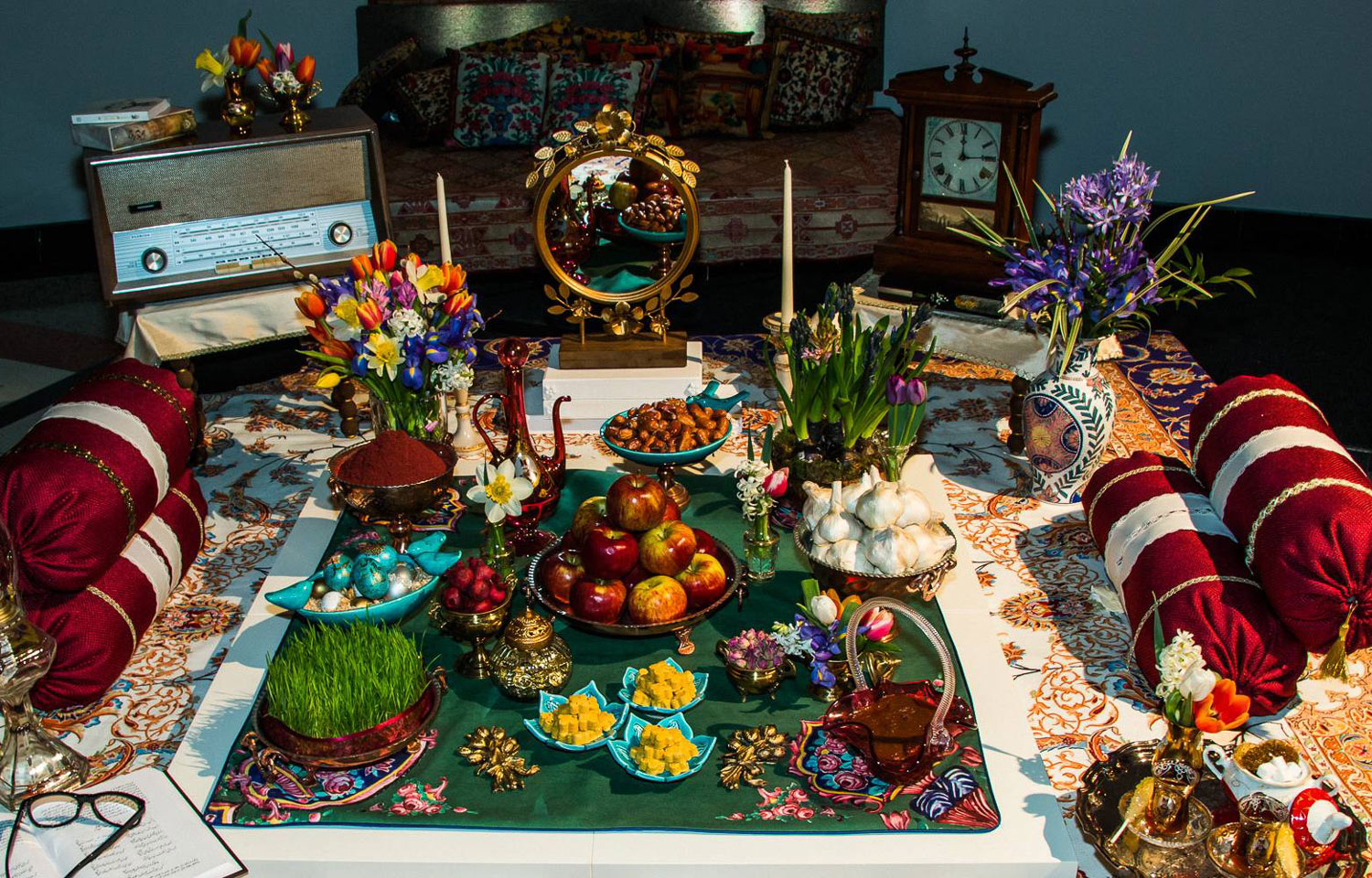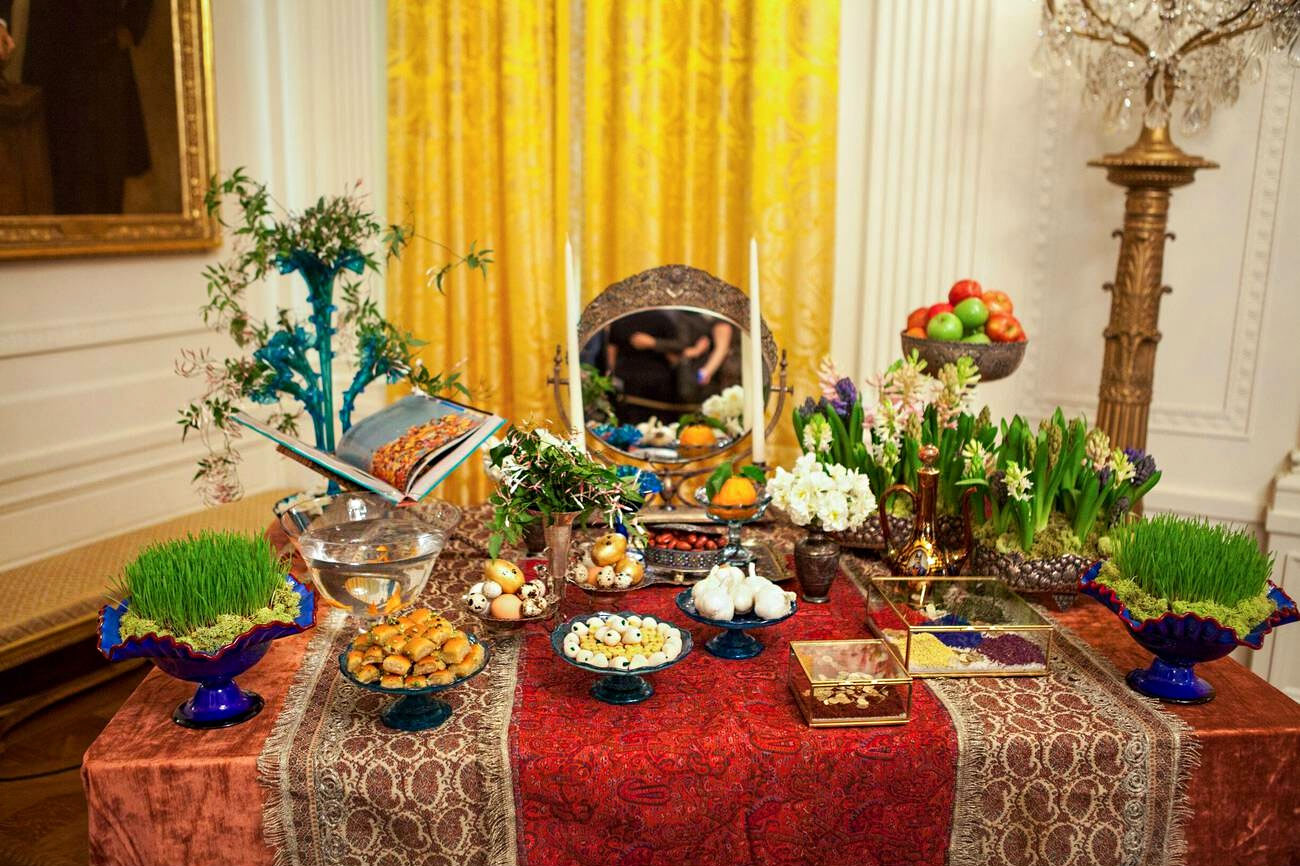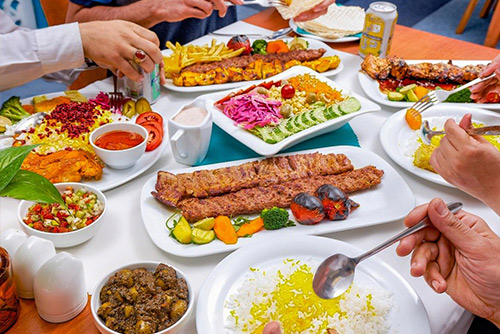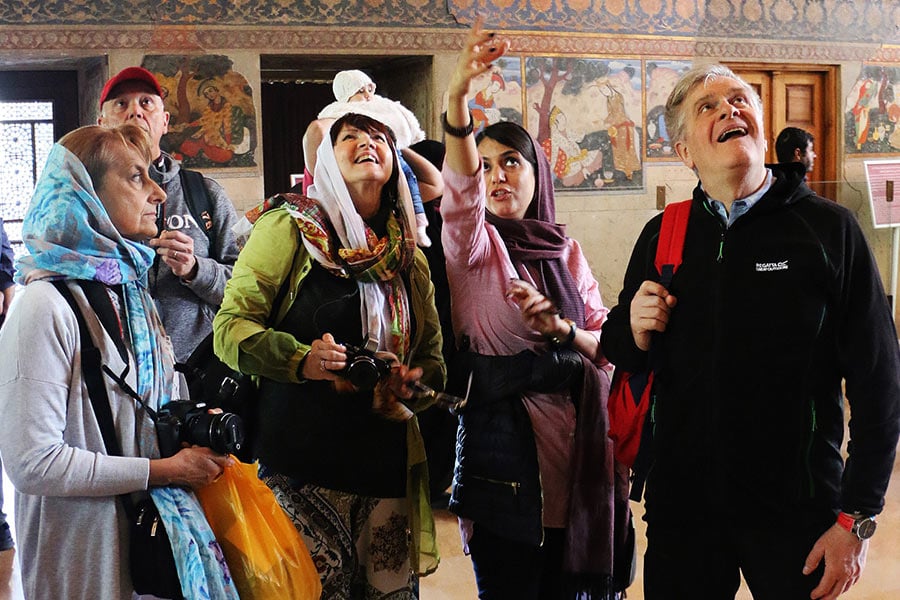
Discover the enchanting tradition of Haft-Sin, the centerpiece of Persian New Year, or Nowruz. This ancient ceremonial table showcases the 7 ‘S’s—seven items starting with the letter ‘S’ in Persian, each symbolizing hope, renewal, and prosperity for the coming year. Dive into a cultural journey that connects families, embraces nature’s rebirth, and celebrates the enduring spirit of Iranian heritage.
Contents
Haft-Sin: The Essence of Nowruz
The Persian New Year, known as Nowruz to Iranians, doesn’t officially begin until a Haft Sin (7 Sin) is arranged to celebrate the arrival of spring.
Persian culture, among the world’s richest, has significantly influenced various other cultures. Often regarded as a cradle of civilization, Iran’s impact across diverse regions and traditions remains evident today.
One of the most beautiful customs which has been celebrated for over 3000 years now is Nowruz.
Nowruz literally means “New Day” and is the start of the Iranian new year, celebrated on the very first day of spring, around 21 March.
For honoring such a great day, Iranian people follow many different customs and traditions. Each one of them has a special meaning and refers to one important and essential aspect of Persian culture.
In this article, we are going to explore Haft-Sin, one of the most beautiful traditions of Nowruz and the hidden meaning behind it.
The Items Of Haft Seen
| Number | Item | Icon | Symbolic Meaning |
|---|---|---|---|
| 1 | Sabzeh |  | Wheat, barley, or lentil sprouts: symbolizing rebirth and growth. |
| 2 | Samanu |  | Sweet pudding made from wheat germ: symbolizing sweetness and fertility. |
| 3 | Senjed |  | Dried oleaster fruit: symbolizing love. |
| 4 | Seer |  | Garlic: symbolizing medicine and health. |
| 5 | Seeb |  | Apple: symbolizing beauty and health. |
| 6 | Somagh |  | Sumac: symbolizing the sunrise and new beginnings. |
| 7 | Serkeh |  | Vinegar: symbolizing age and patience. |
In addition to the above items, some families may also include additional items on their Haft-seen, such as:
- Sekkeh (coins): Symbolizing wealth and prosperity.
- Sonbol (hyacinth flower): Symbolizing spring and the renewal of nature.
- Shirini (sweets): Symbolizing happiness and joy.
- Tokhm-e-Morgh (decorated eggs): Symbolizing fertility and new beginnings.
- Goldfish: Symbolizing life and the flow of time.
- A mirror: Symbolizing reflection and self-reflection.
- Candle(s): Symbolizing light and happiness.
- Holy book(s): Symbolizing spirituality and faith.
The items of Haft-seen can vary depending on the family and region, but they generally all represent good wishes and hopes for the new year.
What is Haft-Sin?

Haft-Sin or Haft-seen, is, in fact, the tradition of putting 7 symbolic objects together whose names commence with S. Other symbolic items accompany these 7 objects and together, they create a Haft-sin. In the past, people used to put all of these items on a mantel or a designed fabric similar to a tablecloth, which they call it “Sofreh”. That’s the reason why Haft-Sin is generally referred to as “Sofreh Haft-Sin”.
Today, most people prefer to set up a table instead of putting it on the floor and using a mantel. But, other parts of this tradition have remained fairly intact and people still follow what their parents and grandparents have done for years.
Before the beginning of the new year, Iranian people start to prepare the necessary items and once their Haft-Sin is set, it will remain in their houses until the last day of the new year’s holidays, which lasts 13 days.

The items vary slightly in different parts of the country, but there are certain elements that define a Haft-Sin. These elements are Sabzeh (wheatgrass grown in a dish), Samanu (sweet pudding made from wheat germ), Senjed (sweet dry fruit of the lotus tree), Serkeh (Persian vinegar), Seeb (apple), Seer (garlic) and Somaq (sumac).
As well as these elements, Iranians tend to put other items such as a mirror, candle, colored eggs, a bowl of water with an orange floating in it, goldfish, coins, hyacinth, and traditional sweets and pastries like nokhodchi.

Another important item is a “book of wisdom”, which can be the Quran, the Avesta, the Shahnameh of Ferdowsi or the divan of Hafiz. When the new year begins, older members of the family open the book and consult the book for a resolution or insight for starting the new year.

Besides, this is the moment when elderlies give money to youngsters and children, which is called “Eidi”. They normally put new banknotes between the pages of the book and as soon as the new year begins, they open it and give the money as a gift to the family members.
The origin of Haft-Sin

During the Kayanids dynasty era, Haft-sin was Haft-sheen (seven SH letters) and the main items included Sharab (wine). As wine is considered to be sinful in Islam, it was replaced with Serkeh (vinegar) after the Islamic conquest of Persia and subsequently, the rest of items were replaced with other elements starting with the letter S. The real significance of seven was to represent the “Seven Eternal Laws”, which embodies the Teachings of Zarathushtra. It was a way of preserving and a reminder of the teachings of Zarathushtra.
What is the meaning behind the seven ‘S’?

Each item in Haft-Sin symbolizes a concept in Persian culture. Sabzeh is a symbol of rebirth and renewal of nature. Samanu represents fertility and the sweetness of life. Senjed is for love and affection. Serkeh (vinegar) symbolizes patience and age. Seeb(apple) is a symbol of health and beauty. Seer (garlic) is for good health and Somaq (crushed spice of berries) symbolizes the sunrise and the spice of life.

The mirror symbolizes the sky and self-reflection. The goldfish and bowl of water represent movement and life. Goldfish is also the sign of the last month in Persian calendar (Esfand) and it turning around the bowl is a sign of turning and changing of the year. the candles bring light to Haft-sin and to life. For fertility, eggs are painted and for wealth and prosperity, people put some coins in their Haft- Sin.

When you think about all these items together, you can easily understand why it is an important part of the beginning of the Iranian new year. Each one of these elements symbolizes a lovely concept and bring us the newness of fresh life, just like the Earth which starts a new life by the arrival of spring.
Read More









Very disappointing article. Pushing forward the bad pronunciation grammar of nowruz and confusing to English readers. That’s WRONG. More accurate is norouz, or noorouz. NO word means NEW. RUZ/ROUZ word sound means DAY. New-Day. I suspect INCORRECT pronunciation of Nowruz comes from poor pronunciation from Afghanistan, which I’ll consider as a result of complete destruction of education for decades there. STOP SPREADING INCORRECT INFORMATION! Because USA was familiar with Afghanistan due to usa war involvements, American personnel assumed Nowruz was correct pronunciation since that was what they got exposed to in villages, which for the most part were poor and not well educated. That American exposure to wrong pronunciation of Farsi or Parsi caused the adoption of wrong spelling representation of nowruz/nowroyz for Norouz.
Also IT’S NOT HAFTSIN OR HAFSIN! No SIN in it. It’s SEEN. Absolutely and ONLY.
No one cares! Stop being such a prick and ASSume things. Do you have a PhD in languages? There’s no right or wrong way to spell words when translating, as Farsi doesn’t use the alphabet. I even know that and I’m not even from that part of the world. I’m from North America.
Thank you to the writer for taking the time to write this and educate me about this holiday.
I enjoyed every bit of the article, mistakes or no mistakes. Enjoy life darling
you do realize there are people outside of Iran that celebrate Nowruz and pronounce it differently….. Turkmen, Azerbaijani, Afghans, Tajiks, Turkish, Kazakh, Kurdish, Albanian, even some Russian people celebrate it. The pronunciation is going to change anywhere you go, your comment literally just looks like you want to be angry at Afghans LMAO
That is the most beautiful thing I’ve ever read. You said it so well. Bravo to you!!!!!!!
Thanks for your time and lovely comment!
Despitete the spelling of the Persian New Year being put into hot debate by some disappointed readers, I must say that this is a beautiful holiday celebrated basically all over the world in some way shape or form. Zoroastrianism’s impact on the major religions of the world is much like the ripple effect seen when throwing a pebble in a pond. Often translated to the simplified “spring festival” don’t be fooled by the lack of precision. The holiday is celebrated directly and by its name of Noruz (“New” is a word of Indo-Iranian origin, so Now-Ruz, No Ruz, No Rooz, and the endless other permuted spellings of the phonetic pronunciation are all acceptable) in Albania (home of the Alan Iraninan tribe) to the Uyghurs in western China, much of southern Russia like Ossetia and Ukraine, to the Asian Steppe countries, Zanzibar, and all throughout the rest of Iranian diaspora around the world. It is a holiday rooted in nature and good will. The origin of the painted egg and even arguably the dress of Santa Claus. It is a holiday that is so old scholars cannot definitively date its origins, but suspect it may be over 10,000 years old.
Thank you for this little window into the heart of this precious holiday. But remember that this is just the TIP of the iceberg that is our collective “New Day”. The first day of spring…. (in the Northern Hemisphere 🙂
This rocked. Thanks for spending the time to write it. Also screw the hater 😉
Thank you so much for writing this article! As a Dutch born Persian it was very useful to look up the traditions again and create the table!
I loved it and don’t feel the disappointment of how you’ve written newroz. There are many variations and yours is just as fine!
Thanks for providing this helpful article.
Some people need to calm their angers down if you know who you are there’s no reason to be so upset if something is missed translated, and then put other peoples country down because you think you’re better than them. For those who really and truly think like this you should seriously get a life and go back to school
Thank you for an illuminating article about this Persian tradition. I am a British-born Iranian and found your article a beautiful explanation of this ancient tradition. It helped me a lot to understand how this tradition developed and what the items on the sofreh symbolise. Many thanks
Thankyou so much for teaching me about Nowruz and the beautiful haft sin table. I work at a preschool in England and really wanted to celebrate Nowruz with all of our children. I have spoken to some of our Kurdish families and got some ideas but really wanted to create our own haft sin display. Hopefully the children will enjoy the activities we’ve prepared. Thankyou
Hi!
Thank you so much for taking time and writing this comment. I hope that the children enjoy it. It is always good to connect with the rythm of the nature and celebrate the beauties of the life.
Wish you a happy new year!
Thank you for this text, all the explanations and the pictures. I was not aware of the Persian New Year until I met a lady from Iran recently, that became my friend. This was a great read to familiarize with.
I am a Christian. I find it amazing that these symbols are also present on our tables when we celebrate things, and they have similar or equal meanings/ serve for similar purposes.
Maria,
I’m glad you found our Nowruz piece insightful. Haft-Sin, a key Nowruz tradition, features seven items beginning with ‘S’ in Persian, each symbolizing hopes for the new year. This practice reflects how various cultures, including Christian traditions, use symbols to convey wishes for prosperity and happiness.
For example, Sabzeh (representing rebirth) echoes the Christian use of greenery during Easter, while Serkeh (symbolizing patience) and Samanu (representing fertility) have parallels in Christian symbols of wine and bread, respectively.
Thank you for sharing your reflections with us, Maria.
Best wishes